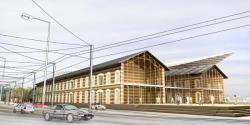CET = Central European Time. CET is also a synonym for a whale. The Mixed Use Development CET at the Kozraktar between the Petofi and the Szabadsag Bridge is both. The CET concept refers to Budapest as an important metropolitan centre in the heart of Central Europe. The CET shape somehow refers to the smooth and friendly streamlined body of a whale. The new CET development has the potential to put Budapest once again on the map of the world. Name and shape of the CET symbolizes its cultural potential and commercial pole position in one of the best preserved cities in the world.
The river Danube fascinates in Budapest for its fast flow on its trajectory downward from the german Schwarzwald to the Black Sea. While the Danube both separates and unites Buda and Pest, the CET aims at re-establishing visual contact at this point between the two sides of the river. Newly planned inviting terraces will visually open the once hermetic Kozraktarak to the University and the Gellért Hotel. Hopefully a watertaxi system will be re-introduced to create direct connections for the people between the two sides as well. The body of the CET landmark building is developed along the flow of the Danube. Its architectural and urban expression evolves with the direction of the flow. The CET’s origin stems from the side of the city centre, grows in size between the two parallel existing buildings of the Kozraktar and then culminates at the south side, the side of the National Theatre and the new Cultural Centre, in a striking landmark building representing the state-of-the-art in architectural design and building technology, not unlike the old long ago removed Elevator Building from the 19th Century wherefrom the goods were distributed by rail to the 6 warehouses which originally occupied the banks of the Danube.
2006




